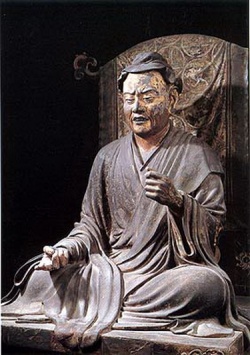Vimalakirti Sutra
Vimalakirti Sutra
維摩経 (Skt Vimalakirti-nirdesha-Sutra; Chin Wei- mo-ching; Jpn Yuima-kyo )
A Mahayana Sutra about the wealthy layman Vimalakirti in Vaishali, translated into Chinese in 406 by Kumarajiva. The full title of Kumarajiva's version is the Sutra on the Expositions of Vimalakirti. The Sanskrit original is not extant. There are a Tibetan translation and two other Chinese translations: one produced by Chih-ch'ien somewhere between 222 and 229 and the other by Hsüan-tsang in 650. Among the three Chinese translations, Kumarajiva's has been the most popular, and the title "Vimalakirti Sutra" generally indicates this version.
Vimalakirti, the protagonist of the Sutra, is a wealthy and prominent citizen of the city of Vaishaliat the time of Shakyamuni. In the Sutra, he represents the ideal lay believer. He is sick in bed and wonders why the compassionate Buddha fails to show some concern for him. Shakyamuni, aware of his Thought, Desires to send someone to inquire after his illness.One after the other, he designates each of his ten major disciples, including Shariputra and Maudgalyayana, and each of the Bodhisattvas, including Maitreya, but each pleads unworthiness, relating a story of how at one time or another he was bested in understanding by Vimalakirti. At length Bodhisattva Manjushri agrees to go.
Vimalakirti, questioned by Manjushri about the nature of his illness, replies that, because all living beings are ill, he is ill; if all living beings are relieved of sickness, then his sickness will likewise be relieved. He further explains that, because Bodhisattvas regard all living beings as their children, it is natural that they will be ill so long as living beings are ill.The Sutra thus sets forth the ideal of the Mahayana Bodhisattva, which is to draw no distinction between self and others. The dialogue between Vimalakirti and Bodhisattva Manjushri continues, and the doctrines of Hinayana are sharply criticized based on the teaching of nonsubstantiality, which this Sutra refers to as Non-duality.
Asked point-blank to define Non-duality, Vimalakirti replies with silence, showing that the true nature of things is beyond the limiting concepts imposed by words. Several commentaries on the Vimalakirti Sutra exist, among them The Annotations on the Profound Meaning of the Vimalakirti Sutra by T'ient'ai (538-579) and The Annotations on the Meaning of the Vimalakirti Sutra attributed to Prince Shotoku (574-622) of Japan.
A Buddhist scripture that has been highly influential in east Asia. The Sanskrit title means ‘The Teaching of Vimalakīrti’, and indeed the principal character and speaker throughout the work is not The Buddha or any high Bodhisattva, but the layman Vimalakīrti. The Sanskrit original was lost long ago, although fragments of it are preserved as quotations in other works, and recently the discovery of a Sanskrit manuscript in the Potala palace in Lhasa was announced in Japan. The work's many qualities—such as its eloquence, orderliness of exposition, and even Humour—have made it a very popular text throughout the World of Mahāyāna Buddhism. According to its translator, Étienne Lamotte, the Sūtra ‘is perhaps the crowning jewel of the Buddhist literature of the Great Vehicle’. He describes it as ‘vibrating with Life and full of Humour’, avoiding the prolixity of other Mahāyāna works while equalling them in the profundity of its teachings.
The Sūtra was translated into Chinese as early as 185 ce, (although this translation has been lost), and was translated six more times after that. The translation made by Kumārajīva around 406 (Taishō 475) is considered the standard among the three still extant. A Tibetan translation also exists, as do other translations (or retranslations from the Chinese or Tibetan) in other languages of central Asia. The primary topic of this Sūtra is the perfection of Insight (Prajñā-pāramitā) teachings of Mahāyāna Buddhism. It also concerns itself to refute Hīnayāna Doctrine, as represented by the ten major disciples of The Buddha who are consistently reproved by Vimalakīrti for their faulty understanding. One of the strengths of the Sūtra is that it teaches by action as well as by word. For example, while it teaches that the concepts of time and space are mere conventions, it also demonstrates this by several miraculous events: the great throng who call on Vimalakīrti in his narrow room somehow all fit comfortably inside it; an entire Buddha-field (Buddha-kṣetra) with all its inhabitants is shrunk so that it fits into the palm of the hand. The distinctions between monastic follower and lay follower and between Buddha and ordinary being are called into question by the person of Vimalakīrti, a layman and ordinary man of the World who nevertheless rivals the Bodhisattva Mañjuśrī himself in understanding. The scripture also shows a Mystical turn in its presentation of the Mahāyāna teaching of Emptiness (śūnyatā). In one of the most famous scenes, called the ‘thunderous silence of Vimalakīrti’, a debate ensued over the proper manner in which to teach this Doctrine. After many participants—culminating with Mañjuśrī—give their understanding, all turn to Vimalakīrti to give the final word, at which point he keeps silent, eloquently demonstrating the ultimate failure of Language to produce a proper understanding of reality. All of these features, along with the wry Humour of many of the episodes (particularly those that produce the discomfiture of The Buddha's disciples) have made this Sūtra a favourite in east Asia, especially within the Ch'an and Zen schools.
